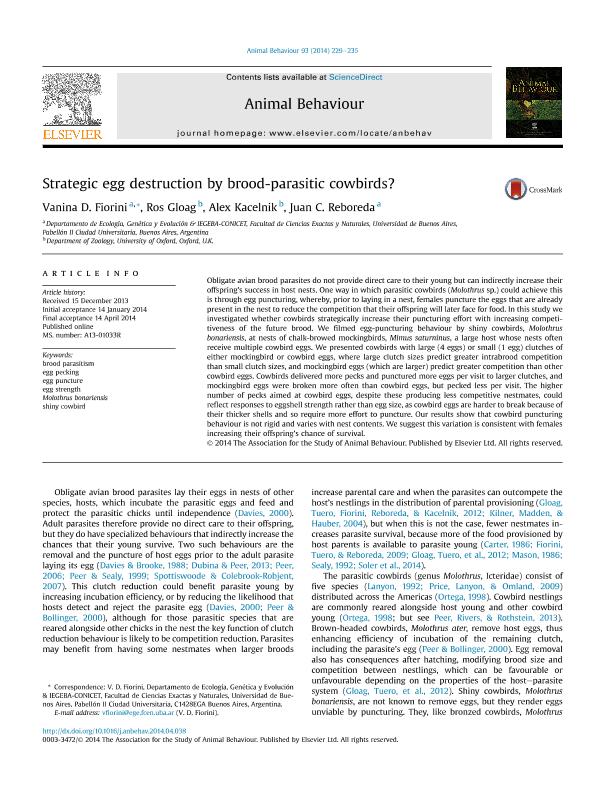Artículo
Strategic egg destruction by brood-parasitic cowbirds?
Fecha de publicación:
06/2014
Editorial:
Elsevier
Revista:
Animal Behaviour
ISSN:
0003-3472
Idioma:
Inglés
Tipo de recurso:
Artículo publicado
Clasificación temática:
Resumen
Obligate avian brood parasites do not provide direct care to their young but can indirectly increase their offspring's success in host nests. One way in which parasitic cowbirds (Molothrus sp.) could achieve this is through egg puncturing, whereby, prior to laying in a nest, females puncture the eggs that are already present in the nest to reduce the competition that their offspring will later face for food. In this study we investigated whether cowbirds strategically increase their puncturing effort with increasing competitiveness of the future brood. We filmed egg-puncturing behaviour by shiny cowbirds, Molothrus bonariensis, at nests of chalk-browed mockingbirds, Mimus saturninus, a large host whose nests often receive multiple cowbird eggs. We presented cowbirds with large (4 eggs) or small (1 egg) clutches of either mockingbird or cowbird eggs, where large clutch sizes predict greater intrabrood competition than small clutch sizes, and mockingbird eggs (which are larger) predict greater competition than other cowbird eggs. Cowbirds delivered more pecks and punctured more eggs per visit to larger clutches, and mockingbird eggs were broken more often than cowbird eggs, but pecked less per visit. The higher number of pecks aimed at cowbird eggs, despite these producing less competitive nestmates, could reflect responses to eggshell strength rather than egg size, as cowbird eggs are harder to break because of their thicker shells and so require more effort to puncture. Our results show that cowbird puncturing behaviour is not rigid and varies with nest contents. We suggest this variation is consistent with females increasing their offspring's chance of survival.
Palabras clave:
Brood Parasitism
,
Shiny Cowbird
,
Egg Pecking
,
Egg Strength
Archivos asociados
Licencia
Identificadores
Colecciones
Articulos(IEGEBA)
Articulos de INSTITUTO DE ECOLOGIA, GENETICA Y EVOLUCION DE BS. AS
Articulos de INSTITUTO DE ECOLOGIA, GENETICA Y EVOLUCION DE BS. AS
Citación
Reboreda, Juan Carlos; Gloag, Ros; Fiorini, Vanina Dafne; Kacelnik, Alex; Strategic egg destruction by brood-parasitic cowbirds?; Elsevier; Animal Behaviour; 93; 6-2014; 229-235
Compartir
Altmétricas




